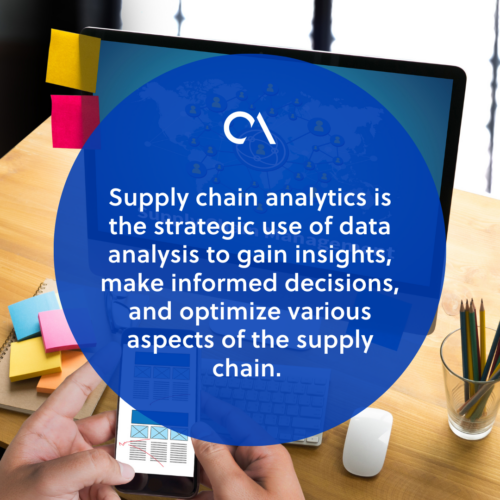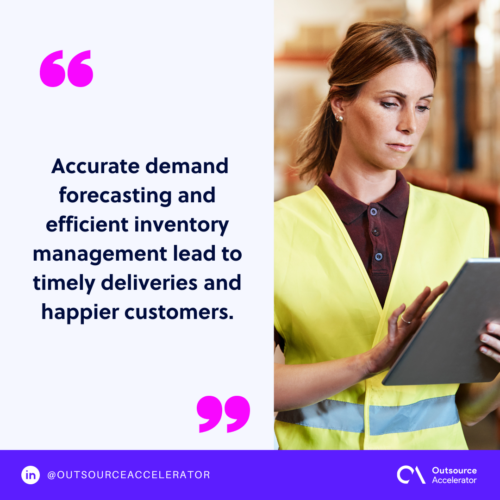Optimizing operations with supply chain analytics

In modern business, the efficiency and effectiveness of supply chain operations play a pivotal role in driving success.
The key to staying ahead lies in harnessing the power of supply chain analytics. Let’s unravel how it’s transforming the way organizations manage their supply chains.
What is supply chain analytics?
Supply chain analytics is the strategic use of data analysis to gain insights, make informed decisions, and optimize various aspects of the supply chain. It’s about converting raw data into actionable insights.
This approach drives improvements, enhances decision-making, and boosts overall supply chain performance.
4 types of supply chain analytics
There are four known types of supply chain analytics:
- Descriptive analytics. It provides a historical view of supply chain activities. Descriptive analytics offers insights into past performance and trends. It’s like looking in the rear-view mirror to understand how the supply chain functions.
- Predictive analytics. This type of analytics uses historical data and advanced algorithms to forecast future supply chain scenarios. It empowers organizations to anticipate demand fluctuations, identify potential risks, and make proactive decisions.
- Prescriptive analytics. Going beyond predictions, prescriptive analytics suggests optimal courses of action to achieve desired outcomes. It helps businesses make informed decisions based on data-driven recommendations.
- Cognitive analytics. It leverages AI and machine learning to process vast amounts of data, uncover hidden patterns, and generate insights that human analysis might miss.

How to use analytics in a supply chain
Businesses can use supply chain analytics in various areas to drive improvements and operational excellence:
Demand forecasting
By analyzing historical sales data, market trends, and external factors, businesses can forecast future demand more accurately.
Supply chain analytics with demand forecasting lets firms:
- Optimize inventory levels
- Allocate resources efficiently
- Meet customer demand
- Minimize stockouts and excess inventory
Inventory optimization
Supply chain analytics helps optimize inventory levels by considering factors like demand variability, lead times, and service-level objectives.
By implementing advanced inventory optimization techniques, enterprises can:
- Reduce carrying costs
- Improve order fulfillment rates
- Prevent stockouts
Supplier performance analysis
Analyzing supplier performance metrics helps evaluate and compare supplier capabilities, quality, and delivery performance.
By identifying underperforming suppliers, businesses can:
- Take corrective actions
- Negotiate better terms
- Mitigate risks associated with supplier disruptions
Transportation planning
Supply chain analytics can optimize transportation routes, modes, and delivery schedules.
By considering factors such as cost, time, and capacity constraints, companies can:
- Improve the efficiency of their transportation operations
- Reduce costs
- Enhance delivery performance
Importance of supply chain analytics
The significance of supply chain analytics cannot be overstated. It empowers organizations to:
- Make informed decisions. Data-driven insights guide strategic decisions, lessening guesswork and promoting efficiency.
- Enhance efficiency. Analytics paves the way for streamlined processes and reduced operational costs by identifying inefficiencies and bottlenecks.
- Improve customer satisfaction. Accurate demand forecasting and efficient inventory management lead to timely deliveries and happier customers.
- Mitigate risks. Predictive analytics helps organizations identify potential disruptions and proactively mitigate risks.
- Foster collaboration. Analytics facilitates data sharing and collaboration across supply chain partners, enhancing overall coordination.

5 C’s of supply chain analytics
Simon Ellis from the IDC research group has outlined the “five C’s” of supply chain analytics. They are widely recognized as key features contributing to a “smart” supply chain:
1. Connected
Supply chain analytics software should integrate with various data sources and systems. This includes ERPs, CRMs, and IoT devices.
This allows businesses to gather and analyze real-time data across the supply chain network.
2. Collaborative
Collaboration lets different teams, departments, and supply chain partners work together and share insights. This promotes cross-functional collaboration and aligns business goals.
As a result, there is better decision-making and coordinated actions.
3. Cyber-aware
Supply chain analytics software should prioritize cybersecurity to ensure data confidentiality, integrity, and availability.
It should include robust security measures and compliance features to protect sensitive information from potential threats and breaches.
4. Cognitively enabled
With AI and machine learning, supply chain analytics software can analyze unstructured data, provide predictive insights, and automate repetitive tasks.
This empowers organizations to make data-driven decisions and focus on strategic initiatives.
5. Comprehensive
An ideal supply chain analytics solution should cover the entire supply chain process. This gives businesses a holistic view of their operations and enables end-to-end optimization.
Future of supply chain analytics
The future of supply chain analytics is poised for exciting advancements. As technology continues to evolve, we can expect:
- Real-time insights. Analytics will provide real-time insights into supply chain operations, enabling organizations to make instantaneous decisions.
- Predictive intelligence. Predictive analytics will become even more precise, aiding with foreseeing potential disruptions and optimizing resources.
- AI-powered automation. Artificial intelligence will play a significant role in automating routine supply chain tasks. This frees up resources for strategic initiatives.
- Blockchain integration. Blockchain technology will amplify traceability and transparency across the supply chain. It will help establish data integrity and reduce fraud.

- Supply chain resilience. Predictive analytics and scenario modeling will help businesses anticipate and mitigate risk. This secures supply chain resilience in the face of disruptions and uncertainties.
- Focus on sustainability. Analytics will be crucial in optimizing energy consumption, reducing waste, and enhancing sustainability practices across the supply chain.







 Independent
Independent




